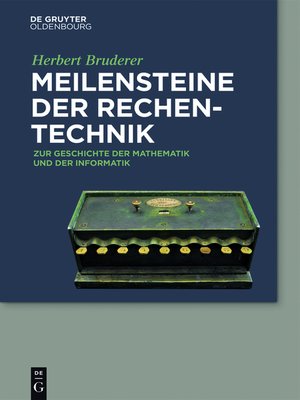Meilensteine der Rechentechnik
ebook ∣ Zur Geschichte der Mathematik und der Informatik
By Herbert Bruderer

Sign up to save your library
With an OverDrive account, you can save your favorite libraries for at-a-glance information about availability. Find out more about OverDrive accounts.
Find this title in Libby, the library reading app by OverDrive.



Search for a digital library with this title
Title found at these libraries:
| Loading... |
During the 1970s mechanical calculating instruments and machines suddenly disappeared from the scene. They were replaced by electronic versions. Most of these devices developed since the 17th century – often very clever constructions – have been forgotten. Who can imagine today how difficult calculation was only a few decades ago? This book introduces the reader to selected milestones from prehistory and early history of computing.
The Antikythera Mechanism
This puzzling device was made around 200 BC. It was discovered around 1900 by divers off the Greek island of Antikythera. It is believed to be the oldest known analog (or rather hybrid) computing device. Numerous replicas have been built to unravel the mysteries of this calendar calculator. It is suspected that the machine came from the school of Archimedes.
Androids, Music Boxes, Chess Automatons, Looms
This treatise also explores topics related to computing technology: automated human and animal figures, mecha-nized musical instruments, music boxes, as well as punched tape controlled looms and typewriters. Also men-tioned are the chess playing machines of the highly gifted Spanish scholar Torres Quevedo (20th century), the magnificent androids (artificial humans) of the Neuchâtel clockmaker Jaquet-Droz (18th century), and his splen-did still functional programmable handwriting automaton "The Writer". A similar machine can also be seen in Vienna.
Schickard, Pascal, and Leibniz
During the 17th century broadly gifted geniuses from Germany and France tried to build calculating machines. Developing a mechanism to perform decimal carry was very challenging. Famous calculators are covered in the text and pictures. These ornate works of art, often circular in form, were popular presents for royalty. Only in the 19th century did makers succeed in producing useful four function calculators. The first successful, commercial-ly produced device was the Thomas Arithmometer, made in Paris. This book lists, for the first time, all the known Swiss makers of mechanical calculating machines and compares their products with one another. The most famous firms were Egli AG (maker of the "Millionaire" and the "Madas") and Pecisa AG. Both companies were located in Zurich. In the 1950s Heinz Rutishauser, the inventor of automatic programming, used a Madas at the ETH (Swiss Federal Institute of Technology) Zurich.
Sectors, Proportional Compasses, Polar Planimeters, Pantographs, and Coordinatographs
Here the discussion is about exceptionally versatile analog calculation instruments such as sectors and propor-tional compasses (dividers). Vanished and forgotten are the products of the world's former leading makers of mechanical integrators such as Amsler (Schaffhausen), Coradi...






